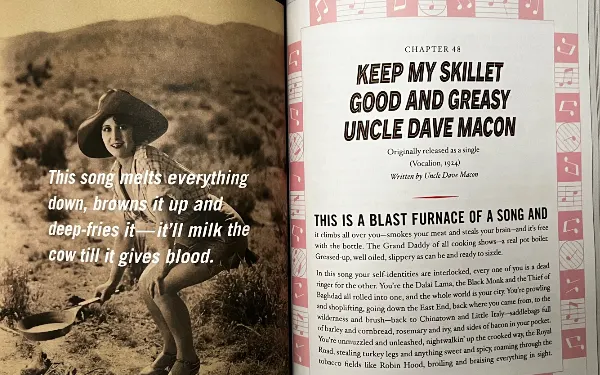Review: The Philosophy of Modern Song
By John Nogowski
The tumultuous response to Nobel Laureate Bob Dylan’s first burst of prose since Chronicles, Vol. 1 – the wryly titled “The Philosophy of Modern Song” offers not a single philosophical analysis per se. The “modern song” part of the title was also a bit of a fake out. Unless, that is, you consider songs by The Clash, Elvis Costello and the late Warren Zevon (a 2003 entry “Dirty Life And Times”) modern. Songs from twenty years ago or so.
They certainly are more recent than, say, the oldest song in the collection, the Stephen Foster classic from 1849 “Nelly Was A Lady.” But modern, as in current? No dice. At 81, were we really expecting Bob Dylan to wax philosophic on Harry Styles, Nas or Taylor Swift?
Virtually every review of this beautifully – and carefully – assembled book immediately leaped to discuss Dylan’s arcane, predictably unpredictable song list – “Gypsies, Tramps, Thieves”? – or the wide-ranging assortment of recording artists we never thought Bob would discuss – Perry Como, Judy Garland, Eddy Arnold and many others – or, shame, shame, the paucity of female recording artists included among the 66 selections.
At this last point, The New Yorker’s formidable Amanda Petrusich was at least disgruntled, bordering on indignant. “Yet that the book contains only four songs performed by women – let that sink in! – is both grim and astounding.” Her counterpunch is her own list of 66 songs (all by women, of course) to settle the score.
Tut, tut. It had to be in my college days that one afternoon, I happened upon a thoughtful essay by literary critic Alfred Kazin on the work of William Faulkner. While Faulkner, a prior Nobel Laureate, has never been a particular favorite of mine, Kazin’s unarguable point has rung in my skull ever since. Acknowledging that for many readers, Faulkner’s involuted, convoluted, seemingly unnecessarily overblown and complicated stories aren’t worth their time, Kazin insists we stand back. “Let the writer have his say,” he writes.
A writer as astute as Petrusich certainly had to be aware that of any author extant, Bob Dylan probably gives less of a shit what his critics across the globe have to say than anyone you can think of. Do you think, after recording a 17-minute song (“Murder Most Foul”) on his most recent album he asked his producer if it was OK? And it went to No. 1! His first!
What we don’t know – and never will, Bob certainly isn’t going to tell us – is his motivation for selecting these 66 songs. Did he intend it to be representative of American music for that time period? Were these the first 66 songs on his Spotify? Did he intentionally leave people off (Bruce Springsteen, U2, The Rolling Stones, etc.) just to annoy? Was he finally, after the decades of duck-dodge-and-hiding about his songwriting process, going to spill the beans, tell us how he did it and why? NOW?
And giving what we’ve learned about his two failed marriages (that we know of) and who dares guess how many liaisons stretching over the years, are we surprised that his view of women, evidenced by his song choice here (“Cheaper To Keep Her”, “Witchy Woman”) might be somewhat skewed?
Surely, Petrusich must remember “Sweetheart Like You” on 1983’s “Infidels” – a song otherwise known as Bob meets Feminism – where he’s nudged into a sort of retraction. When Rolling Stone’s Kurt Loder asks him about the line “a woman like you should be at home…” Dylan goes on the defensive.
“Actually, that line didn’t come out exactly the way I wanted it to,” he said. “But, uh, I could easily have changed that line to make it not so overly, uh, tender, you know? But I think the concept still woulda been the same. You see a fine-lookin’ woman walking down the street, you start goin’ “Well, what are you doin’ on the street? You’re so fine, what do you need all this for?”
When Loder suggested that perhaps these women are going to their jobs. Dylan stiffened. “Well” he said, “I wasn’t talking to that type of woman. I’m not talkin’ to Margaret Thatcher or anything.”
A larger issue may well be what trapped noted essayist Geoff Dyer when it was his turn to explain what Bob was up to.
“Cleverly designed with the Christmas gift market in mind, this cleverly illustrated object is distinctly ownable,” he writes in a review entitled “Bob Dylan has no philosophy” for UnHerd.com. “None of which distracts from – possibly even draws attention to – the foundational problem with the project, a problem inextricably linked with the guarantee afforded by the author’s matchless qualifications, namely the songs. The discrepancy between the quality of Dylan’s own songs and the ones he’s chosen to write about is nothing short of chasmal. I’d estimate that a hundred Dylan songs are better than all but a handful celebrated here. We’d rather be reading Dylan trying to fathom the origins and inner workings of his own songs, so The Philosophy Of Modern Song is actually a stand in what we really wanted for Christmas, Chronicles, Volume 2.”
Do I need to say it again? OK. LET THE WRITER HAVE HIS SAY. For Chrissakes. At 81, do we really think Bob Dylan is going to give us just what he thinks we want? Or what Dyer wants? Instead, shouldn’t we be happy and delighted that the crusty old guy decided to share all these ideas and images and concepts with us? Which isn’t to suggest that he’s above criticism. But being pissed off because he didn’t have enough women or African-Americans or enough rap or people born on Tuesdays seems a bit small-minded. He wasn’t taking orders. He was SHARING.
Maybe it’s me but you can’t read any of “The Philosophy Of Modern Song” and conclude Dylan is mailing it in. He’s alive on the page, excited, full of enthusiasm, digressions, exuberant, alive. Like the Johnny Cash song I just heard while I’m writing this – “I’ve been everywhere, man, I’ve been everywhere.”
That might be an effective superscription for this book. As we should have known by now, 39 albums, two other books, liner notes, interviews, TV appearances, press conferences later, he does not march in a straight line. He may not even know what a straight line is. He’ll write about shoes, war, you name it, it might be in here somewhere. And he mentions plenty of women throughout the book.
The more I read, listen and wander through “The Philosophy Of Modern Song” – it’s exactly that kind of book – the more I wonder if his “message” is broader, more subtle, more elusive. It may be that Bob Dylan collected these songs, the majority of which he may well have first discovered in that magical aural oasis, that hard-to-find these days, mostly vanished location celebrated so beautifully throughout the pages of this book – the record store.
The first photo you see, opening the book is Elvis Presley, in natty white shoes and high-waisted jacket, standing before five rows of albums in a pine-paneled record store offering the latest albums, no classification offered, from Harry Belafonte, Little Richard, “A Tribute To James Dean” and Dean seems to be staring directly at Elvis’s own 1956 RCA release, the purple-shirted Elvis in profile album. (Great album, by the way.)
Flip the page and there’s another record store, catering to African-American audiences it seems, John Dolphins’ legendary record store in Hollywood, with records in plain white jackets, a “Dolphin’s Hit Parade” sign on the wall next to picture of Billy Eckstine. After the Table of Contents, there’s a full-color spread of a Columbia Records employee putting a Mitch Miller disc in a record jacket.
Further inside, there’s a wonderfully colorized picture of Specialty Record story boasting “the largest selection in town of hillbilly records” on Page 38. On page 82, a full colorized shot of a record store displaying Bluebird, Decca, Columbia single and racks chock full of albums. It’s the kind of location where record devotees would stay for hours, flipping through the albums, looking for that collection of sounds that may, sounds crazy to say, change your life. Look at what it did for Bob Dylan. And, well, to a lesser extent, me.
One of the most positive developments I’ve noted in the past few months – and I’m dead serious about this – is finding both our local bookstores – Books-A-Million and Barnes & Noble – now carrying full racks of, yes, VINYL albums. Sure, you can buy whatever you want on Amazon, hear just about anything on YouTube or any number of places on the Internet. But once again, in an actual store, you can walk over, pick up an actual album, look at the cover art, maybe the notes on the back, see what’s out. For yourself. In your hands.
So maybe “The Philosophy of Modern Song” is not just all about these 66 songs. Maybe Bob is mourning, reminiscing about these disappearing magical places, filling in some of the notes that helped construct his personal World Of Song. The carefully selected photos, their placement in the book, back-to-front, perhaps he’s reminding us of the whole passing of the era of a sacred place, the record store.
Look again at that back cover. There are six people in the picture, all men (sorry, Amanda) each of whom seem to be, well, what’s the word, invested. First, you notice the balding guy in the foreground, brown suit and tie, holding a Billie Holiday record, his expression looks as if he just is waiting to tell you how great Billie is. Now this is the 40’s, this album, on Commodore Records, came out in 1947. This guy loves Billie Holiday. Hmmm. Music cuts across race. Even then.
The short-haired guy behind him in a buttoned up plaid shirt seems to be looking carefully through an entire wall full of record albums. What a raft of sound but he’s looking for something particular, very particular. If you’re a record collector, you can relate.
The next guy, dressed exactly like a former Florida State President I knew, ice-cool blue suit coat and natty bow tie has a Kid Ory LP, a jazz trumpeter from the 40’s tucked under his arm and he seems to be making a pitch for the record to a young guy, blond, neatly coiffed in a raincoat, hands in pockets, who looks his son. He could be talking to his dad. Music crossing generations.
Then two bespectacled men, one at the back of the store, standing in front of a sea of sheet music, paying careful attention to the bow-tied man in blue, the man to his right, also in a suit and tie, reaching for something, maybe looking something up. They are all on a mission, I guess, is the bottom line here. Not unlike a Minnesota kid walking into Crippa Music on 313 East Howard Street in Hibbing a few years later. On the same path he once described Elvis on after reading Peter Guralnick’s “Last Train To Memphis.”
“Unrivaled document,” he wrote of Guralnick’s book, “of Elvis as he walks the path between heaven and nature in an America that was wide open, when anything was possible…” And it wouldn’t be wrong to say it started for Bob Dylan as it did for Elvis, in a record store.
That’s something the current generation missed out on. Sure, you can find anything online. But does that match the discovery on site? How could it?
Looking back all these years, I can still remember the thrill of finding an EMI import version of The Best of Jeff Beck with Rod Stewart’s “Drinking Again”, a cut not included on the American release, at the Harvard Coop. Or the amazing record store on Newbury Street in Boston where, having exhausted my Bob Dylan-The Band-Rod Stewart-The Who obsessions having listened to their records to the point where I knew where the little scratches and nicks were, I found an import of Bryan Ferry’s second solo LP – “Another Time, Another Place” with that face-melting version of “The In Crowd” with David O’List going insane, opening up a whole new wing of music for me – Roxy Music, Phil Manzanera, Quiet Sun, Eno, even Andy Mackay’s “In Search of Eddie Riff” – all imports. I bought that particular disc for the version advertised “Wild Weekend.” However, on playing the record, that song was missing! Collector’s item? Or the incredible Third Street Jazz and Rock Store in Philadelphia where I bought the bootleg version of Bob Dylan’s mis-titled “Royal Albert Hall” concert with the “Judas” moment. Or the late lamented Brass City Records in Waterbury, Connecticut, a haven for hard-to-find, out-of-print, even bootleg materials. My first look at “Renaldo and Clara” and “Eat The Document.” Thanks, Walt.
Maybe that’s part of where Bob is going with this book. Wandering through the pages and song descriptions the way you’d flip through a rack of records. And he won’t let you forget about the record stores. There’s another colorized record store shot – “Rivoli records” right next to Emerson Radio and The Varsity Ballroom with a bunch of sailors mesmerized by what’s behind the glass on Page 103. There’s another on page 167, “1125 Records specialists of collectors items” beneath a sign that advertises “Brown’s Talking Picture Opening School,” still another on page 189, a colorized shot of a music store decorated with musical notes, advertising records from Elvis, The Beatles, accordions in the window. The kind of store you might find anything. And everything. I was able to get a 45 RPM of Bob Dylan’s live recording of “Tom Thumb’s Blues” from the 1966 tour, an incredibly rare record, in Louie’s Fruit Stand in Milford, New Hampshire. He sold a few records, too.
When we get to the end of the book, there’s one more shot of someone pressing a vinyl disc. And the back cover, well, there’s that amazing, colorized shot that stays with you and it’s supposed to. It’s the kind of record store you’d want to get lost in.
So maybe “The Philosophy of Modern Song” is less a map than a cloud, a soundcloud if you like. Filled with the kinds of sounds you might hear across a long and fruitful life. The kinds of sounds worth remembering, really listening to. Forever.




